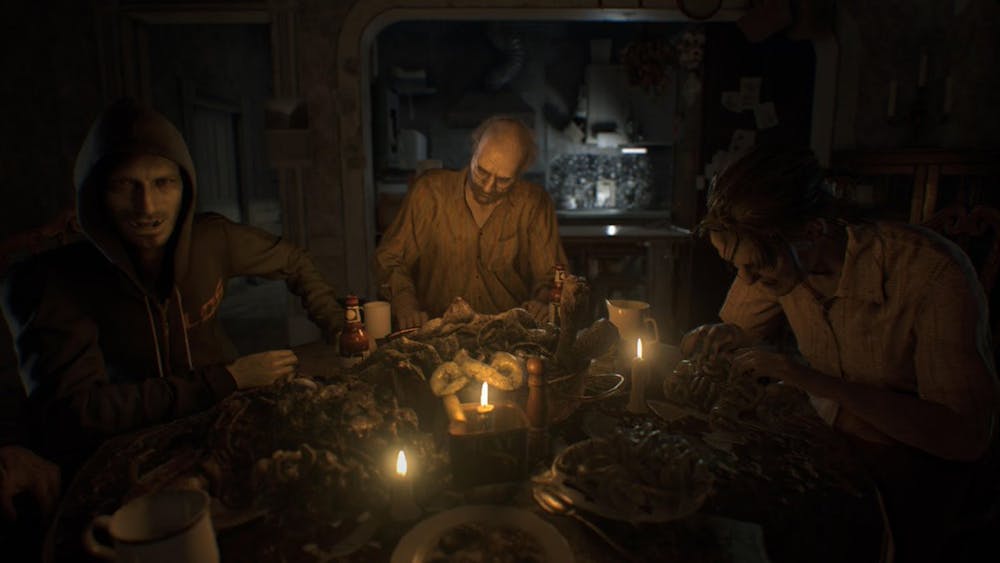Marathoning Capcom’s Resident Evil series takes the player on back-and-forth style shifting.
After the original Resident Evil was released in 1996, it became an iconic staple of the survival horror genre, thrusting the player into an unknown and horrifying situation to fight zombies, giant snakes, killer sharks and other monstrosities that have the sole mission of killing you. With fixed camera angles, tank controls and limited resources, it was up to the player to face their fears and make their way through a puzzle-filled mansion.
Fast forward to 2012, when Resident Evil 6 was released. After over a decade and a half of changes in tone, style and gameplay, the sixth installment of the horror series looked like it was from an entirely different franchise from the debut title. Massive changes aren’t uncommon for long-running video game franchises, as even the most iconic of them will adapt and change to meet the wants of modern audiences.
Resident Evil 6 mostly worked fine as is by itself. Played from the third-person perspective, the game focuses more on creating linear action set pieces for the player to experience rather than putting them in a map with an unsettling horror atmosphere. The core gameplay was fine, but critics and fans alike couldn’t help but notice that this was a far cry from what Resident Evil started out as.
The next main series installment was 2017’s Resident Evil 7: Biohazard. If the slow burning changes from the series’ first title to the sixth were noticeable, then the jump from six to seven really goes the distance. Biohazard feels like a return to the franchise’s roots with enough twists to allow it to stand out on its own. The formula is similar to those of the older Resident Evil games. You play as the faceless Ethan Winters, an ordinary man who travels to an isolated estate in Louisiana to find his missing wife, Mia, who had been presumed dead for years. Of course, it isn’t as easy for Ethan as finding Mia and going home.
After the game’s opening sequence, Ethan finds himself trapped in the home of the infected and now-malicious Baker family, who act as the main threats for the majority of the play-through. Exploring the Bakers’ estate is reminiscent of the franchise’s original formula. The player is presented with a map and is given the task to find key items to solve puzzles and create escape routes to progress, all while dealing with the near invincible threats of the Bakers.
Just the premise alone separates Biohazard from the likes of the main titles of Resident Evil that came directly before it. In the fifth and sixth titles, the campaign stories are told from the perspectives of two characters at a time jumping from location to location. Now, you’re alone as one person stuck in a single situation for a majority of the story.
Biohazard is played from the first-person perspective, at the time a new play-style in Resident Evil. From this viewpoint, the player no longer feels as if they have full awareness of their surroundings like they did in installments just before it. Instead of being able to look over your shoulder by turning the camera like one can in Resident Evil 6, the player now has to turn their entire body around to get a peek behind them, even if doing so slows them down. This helps create some especially tense moments when you’re being stalked by the axe-wielding Jack Baker.
There’s also Ethan himself who’s just... a guy. Unlike the characters you play as in the sixth game, Ethan has little to no idea of the horrific situation he walks into and isn’t exactly trained to deal with the mutated humans out to kill him. Ethan’s character is a 180-degree turnaround from someone like Chris Redfield, one of the protagonists in Resident Evil 6, who’s been dealing with zombies for years now and is essentially a super soldier.
The puzzles and resource management aren’t exactly as difficult and thought-provoking as they are in earlier installments such as Resident Evil 2, but it still keeps the player from going into situations guns-blazing and without a strategy in mind. Once again, wasting items and heading into enemy-infested rooms unprepared may have heavy consequences.
Resident Evil’s focus on action seen primarily in its fourth, fifth and sixth main installments was pretty fun while it lasted, but the positive reception of Biohazard’s near-return to the series’ original formula proved to be a welcome jump back.
Melody Feazell is a senior studying strategic communication at Ohio University. Please note that the views and opinions of the columnists do not reflect those of The Post. What are your thoughts? Tell Melody by tweeting them @MelodyFeaz.






